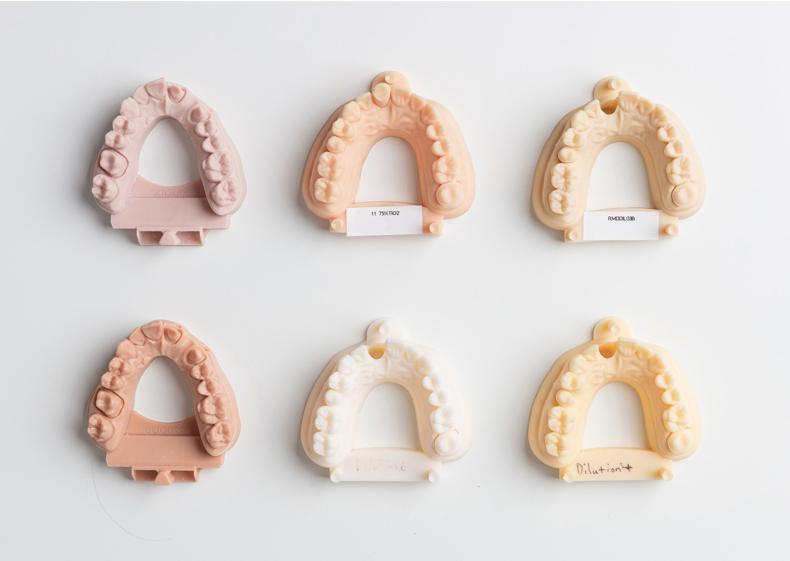3 种常见的光固化 3D 打印技术有什么区别?
光固化成型是最早的3D打印成型技术,也是目前较为成熟的3D打印技术。该技术的基本原理是利用材料的累积成型,将一个三维目标零件的形状分成若干平面层,用一定波长的光束扫描液态光敏树脂,使每一层被扫描部分的液态光敏树脂固化成型,而未被光束照射到的地方仍为液态,最后每一层累积成所需的目标零件,材料利用率可接近100%。
最近,光固化三维打印机发展势头很好,因为打印精度高,可以达到微米级,所以主流三维打印机制造商都推出了相关机型。
不过,相信很多细心的小伙伴已经发现,其实光固化3d打印机并不只有一种,市面上常见的有3种,包括SLA光固化3d打印机、DLP光固化3d打印机和LCD光固化3d打印机。那么,这三种光固化 3d 打印机有什么区别呢?让我们一起来看看。
首先,SLA 光固化 3D 打印机
SLA 技术是第一代光固化主流技术,它在中国有多种译名,如三维光刻、三维印刷、光造型等。SLA 成型技术不仅是世界上最早出现并商业化的一种快速成型技术,也是目前研究最深入、应用最广泛的快速成型技术之一。
SLA 成型技术的基本原理是,主要通过使用紫外激光(355nm 或 405nm)作为光源,并由振动镜系统控制激光光斑扫描,激光束在液态树脂表面勾勒出物体第一层的形状,然后在制作平台上向下移动一定距离(0.05-0.025mm 之间),再让固化层浸入液态树脂中,如此反复,最终完成实体打印。
二、DLP 光固化 3D 打印机
数字光处理(Digital Light Processing,缩写:DLP)是在 SLA 技术出现十多年后出现的,该技术也是业界公认的第二代光固化成型技术,发展历史距今已有 20 多年。DLP 技术最早由德州仪器公司开发,是一种增材制造技术,利用投影仪逐层固化光敏聚合物液体,从而制造出 3D 打印物体。
这种成型技术先用切片软件将模型切成薄片,投影仪播放幻灯片,每层图像在树脂层很薄的区域产生光聚合反应固化,形成一层薄薄的零件,然后成型台移动一层,投影仪继续播放下一张幻灯片,继续加工下一层,如此循环,直到打印结束,这样不仅成型精度高,而且打印速度也非常快。
第三,LCD 光固化 3D 打印机
上面对基于 SLA 和 DLP 两种成型技术的 3d 打印机说了很多,现在我们来谈谈新型光固化产品 LCD 光固化 3D 打印机。
LCD 光固化成型技术其实在 2013 年才刚刚出现。关键是这项技术是开源的,核心部件也非常便宜。
我们来谈谈他的成型原理。其实与 DLP 成型技术相比,对 DLP 技术最简单的理解就是光源用 LCD 代替,其他基本类似。LCD 的液晶板成像原理,是利用光学投影通过红、绿、蓝三原色滤光片过滤掉红外线和紫外线(红外线和紫外线对液晶板有一定的破坏作用),然后将三原色投影通过三块液晶板,合成投影成像。
不过,这种成型技术需要使用大功率紫外线照射,并利用极少量的透射紫外线进行固化成型。而液晶屏本身怕紫外线,会在照射后迅速老化,而核心部件除了要经受高温散热的考验外,还要经受几十瓦的 405 颗 LED 灯珠几个小时的高强度烘烤,因此使用寿命很短。如果经常使用,其核心部件液晶屏往往在一到两个月内就会损坏。
四、三种印刷技术的比较
今天,我们将介绍并对比这三种技术中较为常见的 SLA、DLP 和 LCD 技术。
成型速度:DLP>LCD>SLA
打印精度:DLP>SLA>LCD>FDM
打印尺寸范围SLA>DLP>LCD
材料范围:(DLP≈LCD)>SLA
主要部件的使用寿命:DLP≈SLA>LCD
机器价格:SLA>DLP>LCD
耗材价格:SLA≈DLP≈LCD
适用范围。
SLA:精细零件,如手机、收音机、对讲机、鼠标、玩具、电子工业外壳、电器外壳或模型、摩托车、汽车零件或模型、医疗设备等。
DLP: 小型精密零件、牙科模具、义齿牙龈导板等牙科、珠宝、研发实验、手板模型、医疗设备
LCD:个人创作、娱乐。较小尺寸机型
V.SLA 和 DLP 两种成型技术的区别
SLA和DLP使用的耗材都是光固化树脂,而且两者的成型技术原理非常相似,所以业界在研究3d打印成型技术时,往往喜欢把这两种技术当作相似的技术,但两者在很多方面其实还是存在差异的。
1.机械结构:DLP 使用投影仪的数字光源,而 SLA 使用紫外激光光源。
2.成型速度。由于 DLP 的工作原理是利用数字微镜元件将产品横截面图形投射到液态感光树脂表面,使被照射的树脂逐层光固化,因此打印速度非常快;而 SLA 则是利用激光束在液态树脂表面勾勒物体轮廓,由点到线,再由线到面形成实体模型,因此工作效率远低于前者。
3.印刷精度。理论上,两者的精度都可以达到微米级的印刷精度,DLP 可以达到最小光斑尺寸±50 微米,而 SLA 可以达到最小光斑尺寸±100 微米。由于 SLA 激光器的功率较高因而容易导致光斑误差的形成,另外微米级精度对于 SLA 激光器的主要部件和反射镜的要求都很高,一般国产振镜很难达到要求,要达到微米级成本会大幅增加。相比之下,DLP 更容易达到微米级。综上所述,DLP 的打印精度要高于 SLA。
4. 打印尺寸。DLP 受限于数字镜面的分辨率,与 SLA 相比只能打印较小尺寸的产品。
总的来说,两种技术各有利弊,但在实际应用中,DLP 3D 打印机显然更具优势。
紫外线单体 同系列产品
| 聚硫醇/聚硫醇 | ||
| DMES 单体 | 双(2-巯基乙基)硫醚 | 3570-55-6 |
| DMPT 单体 | THIOCURE DMPT | 131538-00-6 |
| PETMP 单体 | 7575-23-7 | |
| PM839 单体 | 聚氧(甲基-1,2-乙二基) | 72244-98-5 |
| 单官能团单体 | ||
| HEMA 单体 | 甲基丙烯酸 2-羟乙基酯 | 868-77-9 |
| HPMA 单体 | 甲基丙烯酸羟丙酯 | 27813-02-1 |
| THFA 单体 | 丙烯酸四氢糠酯 | 2399-48-6 |
| HDCPA 单体 | 氢化双环戊烯丙烯酸酯 | 79637-74-4 |
| DCPMA 单体 | 甲基丙烯酸二氢双环戊二烯酯 | 30798-39-1 |
| DCPA 单体 | 丙烯酸二氢双环戊二烯酯 | 12542-30-2 |
| 二氯丙烯酰亚胺单体 | 甲基丙烯酸二环戊氧基乙酯 | 68586-19-6 |
| DCPEOA 单体 | 丙烯酸二环戊烯基氧基乙基酯 | 65983-31-5 |
| NP-4EA 单体 | (4) 乙氧基化壬基酚 | 50974-47-5 |
| LA 单体 | 丙烯酸十二烷基酯/丙烯酸十二烷基酯 | 2156-97-0 |
| THFMA 单体 | 甲基丙烯酸四氢糠酯 | 2455-24-5 |
| PHEA 单体 | 2-苯氧基乙基丙烯酸酯 | 48145-04-6 |
| LMA 单体 | 甲基丙烯酸月桂酯 | 142-90-5 |
| IDA 单体 | 丙烯酸异癸酯 | 1330-61-6 |
| IBOMA 单体 | 甲基丙烯酸异冰片酯 | 7534-94-3 |
| IBOA 单体 | 丙烯酸异冰片酯 | 5888-33-5 |
| EOEOEA 单体 | 2-(2-乙氧基乙氧基)丙烯酸乙酯 | 7328-17-8 |
| 多功能单体 | ||
| DPHA 单体 | 29570-58-9 | |
| DI-TMPTA 单体 | 二(三羟甲基丙烷)四丙烯酸酯 | 94108-97-1 |
| 丙烯酰胺单体 | ||
| ACMO 单体 | 4-丙烯酰基吗啉 | 5117-12-4 |
| 双功能单体 | ||
| PEGDMA 单体 | 聚乙二醇二甲基丙烯酸酯 | 25852-47-5 |
| TPGDA 单体 | 三丙二醇二丙烯酸酯 | 42978-66-5 |
| TEGDMA 单体 | 三乙二醇二甲基丙烯酸酯 | 109-16-0 |
| PO2-NPGDA 单体 | 丙氧基新戊二醇二丙烯酸酯 | 84170-74-1 |
| PEGDA 单体 | 聚乙二醇二丙烯酸酯 | 26570-48-9 |
| PDDA 单体 | 邻苯二甲酸二乙二醇二丙烯酸酯 | |
| NPGDA 单体 | 新戊二醇二丙烯酸酯 | 2223-82-7 |
| HDDA 单体 | 二丙烯酸六亚甲基酯 | 13048-33-4 |
| EO4-BPADA 单体 | 乙氧基化 (4) 双酚 A 二丙烯酸酯 | 64401-02-1 |
| EO10-BPADA 单体 | 乙氧基化 (10) 双酚 A 二丙烯酸酯 | 64401-02-1 |
| EGDMA 单体 | 乙二醇二甲基丙烯酸酯 | 97-90-5 |
| DPGDA 单体 | 二丙二醇二烯酸酯 | 57472-68-1 |
| 双-GMA 单体 | 双酚 A 甲基丙烯酸缩水甘油酯 | 1565-94-2 |
| 三官能单体 | ||
| TMPTMA 单体 | 三羟甲基丙烷三甲基丙烯酸酯 | 3290-92-4 |
| TMPTA 单体 | 三羟甲基丙烷三丙烯酸酯 | 15625-89-5 |
| PETA 单体 | 3524-68-3 | |
| GPTA ( G3POTA ) 单体 | 丙氧基三丙烯酸甘油酯 | 52408-84-1 |
| EO3-TMPTA 单体 | 三羟甲基丙烷三丙烯酸乙氧基化物 | 28961-43-5 |
| 光阻单体 | ||
| IPAMA 单体 | 2-异丙基-2-金刚烷基甲基丙烯酸酯 | 297156-50-4 |
| ECPMA 单体 | 1-乙基环戊基甲基丙烯酸酯 | 266308-58-1 |
| ADAMA 单体 | 1-金刚烷基甲基丙烯酸酯 | 16887-36-8 |
| 甲基丙烯酸酯单体 | ||
| TBAEMA 单体 | 2-(叔丁基氨基)乙基甲基丙烯酸酯 | 3775-90-4 |
| NBMA 单体 | 甲基丙烯酸正丁酯 | 97-88-1 |
| MEMA 单体 | 甲基丙烯酸 2-甲氧基乙酯 | 6976-93-8 |
| i-BMA 单体 | 甲基丙烯酸异丁酯 | 97-86-9 |
| EHMA 单体 | 甲基丙烯酸 2-乙基己酯 | 688-84-6 |
| EGDMP 单体 | 乙二醇双(3-巯基丙酸酯) | 22504-50-3 |
| EEMA 单体 | 2-甲基丙-2-烯酸 2-乙氧基乙酯 | 2370-63-0 |
| DMAEMA 单体 | 甲基丙烯酸 N,M-二甲基氨基乙酯 | 2867-47-2 |
| DEAM 单体 | 甲基丙烯酸二乙氨基乙酯 | 105-16-8 |
| CHMA 单体 | 甲基丙烯酸环己基酯 | 101-43-9 |
| BZMA 单体 | 甲基丙烯酸苄酯 | 2495-37-6 |
| BDDMP 单体 | 1,4-丁二醇二(3-巯基丙酸酯) | 92140-97-1 |
| BDDMA 单体 | 1,4-丁二醇二甲基丙烯酸酯 | 2082-81-7 |
| AMA 单体 | 甲基丙烯酸烯丙酯 | 96-05-9 |
| AAEM 单体 | 甲基丙烯酸乙酰乙酰氧基乙基酯 | 21282-97-3 |
| 丙烯酸酯单体 | ||
| IBA 单体 | 丙烯酸异丁酯 | 106-63-8 |
| EMA 单体 | 甲基丙烯酸乙酯 | 97-63-2 |
| DMAEA 单体 | 丙烯酸二甲胺基乙酯 | 2439-35-2 |
| DEAEA 单体 | 2-(二乙基氨基)乙基丙-2-烯酸酯 | 2426-54-2 |
| CHA 单体 | 丙-2-烯酸环己基酯 | 3066-71-5 |
| BZA 单体 | 丙-2-烯酸苄酯 | 2495-35-4 |





